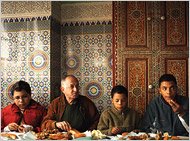
A chicken (una gallina) arrived about a month ago and took up residence in the neighbor’s yard. The neighbors are two people, an elderly Italian lady and her twenty-something son. Their family has been in the neighborhood more than sixty years, much like mine, and they have stayed in the neighborhood all this time (much unlike mine). The chicken has lived in their yard, pecking around in the grass eating god-knows-what, slogging through five-inch deep May downpour puddles, sleeping in the hibiscus trees in the front of the one-story 1920’s brick bungalow.
Yesterday we awoke to sounds of thrashing, the neighbor boy was running around the yard chasing the chicken with the help of his little terrier, chasing the chicken with a stick. When asked what he was doing, he said: I’m at my wits end, that chicken is terrorizing my cats, the chicken eats all the cat food, it doesn’t let the cats eat the food, it is out of control —¡that wily chicken!— and I’ve had enough.
A step back: we had tried about a month ago when the chicken first arrived to take the it before and move it to our yard, but he flew over the fence and went back to the neighbor’s yard. Now we knew why: the cat food.
But now watching the neighbor boy chase the chicken, we decided that the chicken had to have a better home. We told the neighbor boy to stop chasing the chicken, that it was much easier to catch a chicken at night as they slept.
So last night we climbed up on a small ladder, step stool type thing and took that chicken. Pero, y aquí el gran pero, nuestro amigo tamaulipeco que vive en la casa con nosotros nos aconsejo que el mejor idea sería de atar un hilito a la patita de la gallina para que no se escapara en la noche. También otros dijeron que así se hacía en el rancho. Que se tenía que atar la gallina a un árbol o ligar sus dos patitas para que no caminara tanto. So on the advice of this friend we tied a string to the gallina’s patita and tied it to a tree.
In the morning, we found the chicken hanging from the tree. Se había enrededado por completo en el árbol. We got him loose. The chicken, we thought, must have a broken leg or a broken wing. It sat still in the dirt, didn’t move, didn’t try to escape, looked traumatized. We learned from our mistake. We wouldn’t tie any chicken, ever again, so we put it in a box with chickenwire across the top to keep the gallina inside. Later, today, the chicken seemed to be fine, it even escaped from the box and tried to get away. But I caught it, put it back in the box and secured the chickenwire top.
During my lunchbreak, I went to Hendrick’s Feed Supply, Founded 1923, an oldtime feedstore on Harrisburg in the middle of Magnolia. Who knows how this feedstore survives almost a century later despite all the changes? I bought the hen a mixture of normal feed (4lbs) and special pellets that help with egg laying (3lbs). Total $2.74.
We named the gallina-hen, Clementina, on the suggestion of a friend who always wanted to name a gallina, Clemenina. Y además, Clementina es naranja y así que tiene sentido llamarle Clementina.
Clementina is like Hendrick’s is like me. Reaching for the past. A legacy of rural life, a living breathing connection to the past. To the grandmother whether here in el East End or allá en el rancho norteño que siempre cuidaba sus gallinas. For the store that refuses to die despite it all, the Wal-Marts, the agrodecline, who finds a place for feedstore on a street now full of thrift stores, Las Palmas strip mall, El Charro taquería, La Marbella banquet hall, Fallas Paredes, Firestone, murals of Lidia Mendoza playing the accordeon, cholos and agringados, old Italian ladies, and who keeps chickens anymore? A lot of people, a lot of people, in the belly of the beast, in the glossy, flossy postmodern city, in this place where there is supposedly nothing natural, where the rain is chemicals and scorched hot by the firey burn-off from the smokestacks of the refinery.
Chickens escape. Las gallinas vagan por las calles, se asentan en los patios de los viejos residentes, se enredan en los arboles y cuelgan esperando hasta que alguien las salve. And somehow Clementina found her way to our backyard. Now we just have to learn how to take care of her, how to take care of our roots, what we’ve lost, how to recover it, how not to get broken and lost, killed by the neighbor in a fit of anxiety or rage, how not to get lost in the cracks.









